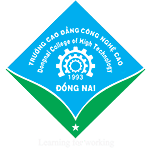- Bài viết của BGH
- Ý kiến người học
- Ý kiến Phụ huynh - Học sinh
- Hợp tác Doanh nghiệp
-
Lịch công tác
- Thời khóa biểu
- Qui định nội bộ
- Phòng chống tham nhũng
- Tài liệu cho viên chức - GV
- Tài liệu cho HSSV
- Hỗ trợ NN DIOXIN / Khuyết tật
- Văn phòng điện tử V-Office
- Thư viện ảnh
- Luật giáo dục nghề nghiệp
- Thư viện điện tử
- Phòng chống dịch Covid-19
- Dân chủ cơ sở và dân vận chính quyền
Liên kết website
- Giới thiệu
- Tổng quan
Tổng quan
 |
Dongnai College of High Technology |
| Learning For Working |
It was established firstly as Long Thanh Vocational Training Employment Centre according to the Decision No 53/QĐ.UBH dated 8 February 1993 made by Chairman of Long Thanh People’s Committee.
In order to meet the demands of the professional vocational training from workers and technical human resources, the Minister of MOLISA issued the Decision No 225/QĐ-LĐTBXH of 27 February 2012 on establishing the Vocational Training College of Long Thanh – Nhon Trach area.
1. Function
The main function of the College is vocational training and employment for the workers, is the bridge between workers and enterprises.
2. Task
2.1 Develop programs, materials of vocational training activities which are registered.
2.2 Organize exams, tests and grant profession certificates following the regulation stipulated by the Minister of MOLISA.
2.3 Recruit, manage the College teachers and personnel.
2.4 Conduct, apply and transfer scientific researches as stipulated by the law.
2.5 Provide free consultation on vocational training and employment to apprentices.
2.6 Organize study tour and trainee program in the enterprises.
2.7 Use and manage land, material facilities, equipment and funds following the law.
2.8 Do regular and unscheduled reports as stipulated.
3. Authority
3.1 Take the initiative in develop and implement College’s development plan.
3.2 Can receive funds/donor support, use and manage different resources to carry out the vocational training activities according to the stipulated law.
3.3 Associate with other economic, educational and scientific research organizations in Vietnam and abroad in order to improve the vocational training quality and make it satisfy the requirements of employment and labour market.
3.4 Conduct vocational trainings for 16 main jobs:
|
1. Electrical Industry |
9. Graphic Design |
|
2. Refrigeration |
10. Web Design |
|
3. Industrial Electronics |
11. Computer Programmer |
|
4. Mechatronics |
12. Accounting |
|
5. Automotive Engineering |
13. Cooking and Restaurant Service |
|
6. Machine Tool Repair |
14. Garment –Fashion Design |
|
7. Mechaning Machinery |
15. Environmental Technology |
|
8. Advanced Power Management |
16. Chemical engineering |
4. Organizational structure
4.1 Departments of training, Accounting, Student management, Administration.
4.2 Faculties of Electrical and Electronic, Information Technology, Accounting, Mechanical and Automotive, Garment – Fashion Design, Cooking and Restaurant Service.
5. Overview of the College material facilities
5.1. Building 1: (has constructed from the year of 2001): 15,000m2
- Theory teaching rooms: 09
- Workshops for work practice: 21
- Meeting hall: 01 (250 seats)
5.2. Building 2: Upgrade and enlarge during the period of 2010-2011: 18,000m2
6. Served objectives
- People in the working age in the rural areas, people were revoked lands, disabled people, poor people, orange/dioxin victims.
- Workers working in the enterprises that have vocational training demands.
- Enterprises in the industrial, trade and service fields.
7. Main activities and achievements
7.1 Providing short term and primary job training to 51,255 people (including training for 43,972 enterprises’ workers accounted over 85%);
7.2 From 2009 educating 35 people who showed aptitude for Robot design (02 courses).
7.3 Supporting the whole life of 10 orange /Dioxin victims, providing vocational training for disabled people.
7.4 Helping to find the jobs for over 24,000 workers during the year of 1993-2010.
7.5 Providing labourers to over 25 enterprises and ecological tourist areas.
7.6 Providing vocational training to the workers who were revoked lands in the HCM City-Long Thanh-Dau Giay highway project sponsored by ADB (2010-2011).
7.7 Gaining 2nd prize in the national contest of vocational training equipments and tools in 2010.
7.8 Providing long term and intermediate vocation to 3,182 people (2002-2009).
7.9 Providing vocation of intermediate level to 1,360 people:
(Especially from May 2010 the applied graphic course has attracted the participation of 14 disabled people).
8. Advantages and disadvantages
8.1. Advantages/Opportunities
- The College operates in the areas which are concentrated together many industrial zones (15 industrial zones, accounts for 60% ones in Dong Nai province), therefore there are a lot of enterprises which have ordered workers’ recruitment;
- The College is located in Dong Nai province which has big projects such as the International Long Thanh Airport with the area of 5,000 square metes, residential and service areas that can serve the Airport with 21,000 square meters, HCM City – Long Thanh – Dau Giay Highway project, Son Tien Ecological Tourist area, Long Thanh High Technology area . . .);
- The College have received supports from the government in enlarging and building workshops;
- Its staff is young (average age is 30-35) and having practical experience. They have been trained annually.
8.2. Difficulties/Challenges
- Enterprises have expected higher labour standards, especially higher requirements on technical/competent and soft skills;
- The teachers have not many opportunities to approach new technology. Their foreign language is weak and as a result they are not confident in communication with foreigners;
- Teaching facilities/equipments even being invested but are lack according to the enterprises’ technical requirements;
- The workers and enterprises can not pay much for training costs because the received income of technical workers at the enterprises is not high.
9. Activities Orientation
9.1 Conduct a survey on the enterprises’ demands of the labourers in order to adjust training programs, methodology and even increase professions to meet the requirements of the enterprises.
9.2 Organize regularly online surveys of the trainees’ comments to improve the training quality as well as update them with the College activities.
9.3 Corporate with the enterprises in organizing workshops on professional skills at workplaces, trainees’ programs, study tours in order to make the trainees be well prepared to the knowledge, skills and attitude that the enterprises require. The teachers have been supported to enhance their English language and knowledge of applied scientific research to the vocational training.
9.4 Look for any support from the government and enterprises in modernizing training equipments/facilities to meet the enterprises’ demands.
9.5 Conduct vocational trainings for disabled people, poor people, land revoked people, rural labourers…). Link the training with employment at the enterprises.
9.6 Organize intermediate vocational trainings of 14 registered jobs during the period of 2010-2015, concentrating on Electrical and Electronic, Advanced Power Management, Graphic Design, Motor Technology, Accounting and Corporate Management, Cooking and Restaurant Service.
Organize elementary vocational trainings (under 6 months) for the enterprises’ staff on operating lifting machines, steam boiler, labour occupational safety and hygiene…


